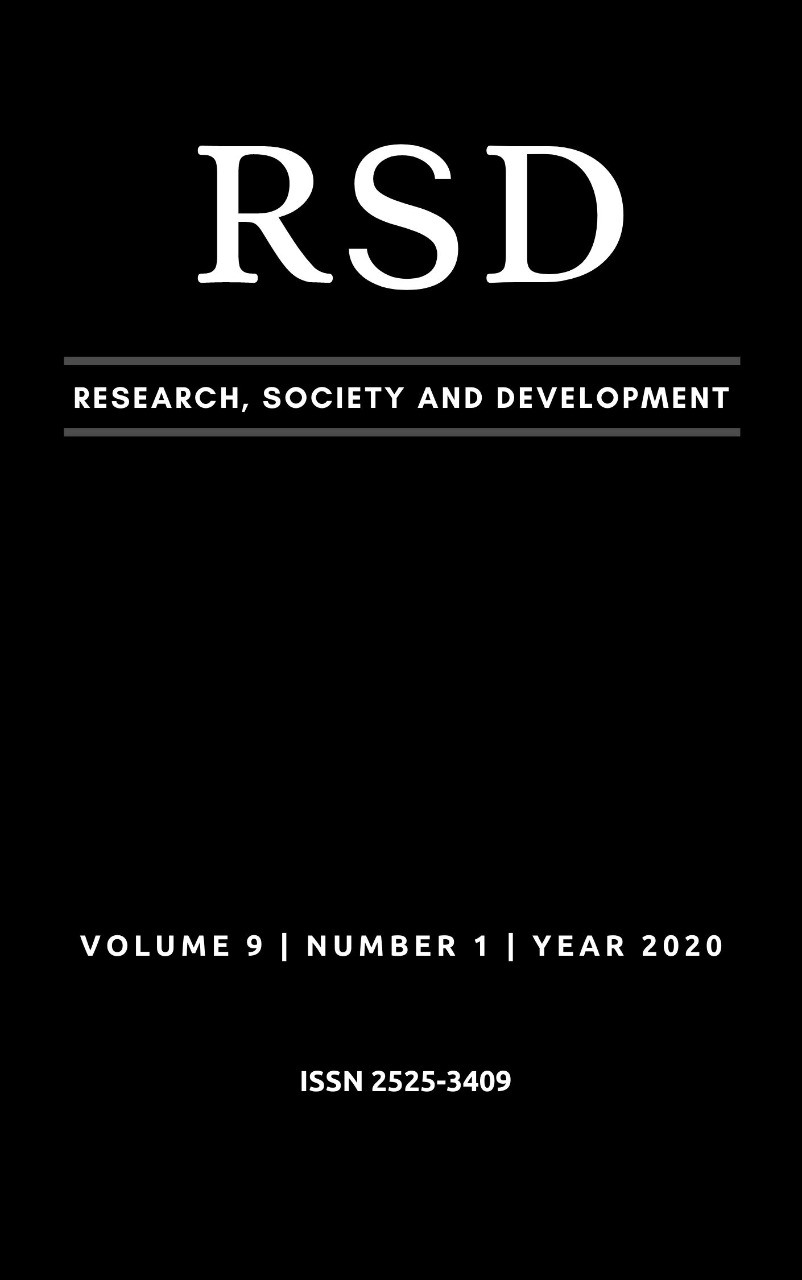Análise granulométrica diferencial da farinha da casca de jabuticaba (Myrciaria cauliflora Berg) Differential particle size analysis of jabuticaba bark flour (Myrciaria cauliflora Berg)
DOI:
https://doi.org/10.33448/rsd-v9i1.1875Palavras-chave:
Peneiramento, Produto funcional, Secagem convectiva.Resumo
O presente artigo tem como objetivo produzir e avaliar o perfil granulométrico diferencial da farinha da casca de jabuticaba. A farinha da casca de jabuticaba foi obtida através do processo de secagem convectiva, realizada em estufa de circulação de ar na temperatura de 50 °C e velocidade de 1,0 m/s durante 24 h. A análise granulométrica foi realizada através do peneiramento de 50 g de farinha de casca de jabuticaba, utilizado uma série de peneiras padronizadas na faixa de 9 a 200 Mesh. Os modelos matemáticos ajustados aos dados experimentais foram o de Gates-Gaudin-Schuhmann (GGS) e o de Modelo de Rosin-Rammler-Bennet (RRB). A partir dos dados experimentais obtidos foi verificado que, a farinha da casca de jabuticaba analisada está de acordo com os critérios da legislação para classificação granulométrica. Dentre os modelos matemáticos aplicados o de Rosin-Rammler-Bennet (RRB), foi o que melhor se ajustou aos dados experimentais com coeficiente de determinação (R2) superior a 0,99, além disso apresentando também o maior ângulo de inclinação da reta. Vale salientar que o diâmetro médio das partículas obtidas para farinha fina não diferiu do valor encontrado de forma experimental. E que 27,62% para um total de 50 gramas da farinha apresentou uma granulometria fina, menor que 60 mesh, o que é esperado e satisfatório para as características de farinha, apresentando potencial de utilização no desenvolvimento de novos produtos alimentícios.
Referências
Almeida Neta, M., Rocha de Queiroga, A., Almeida, R., Caetano Soares, A., Marinho Gonçalves, J., Soares Fernandes, S., & Rolim Florentino, E. (2018). Fermented Dessert with Whey, Ingredients from the Peel of Jabuticaba (Myrciaria cauliflora) and an Indigenous Culture of Lactobacillus plantarum: Composition, Microbial Viability, Antioxidant Capacity and Sensory Features. Nutrients, 10(9), 1214.
Banerjee, J., Singh, R., Vijayaraghavan, R., MacFarlane, D., Patti, A. F., & Arora, A. (2017). Bioactives from fruit processing wastes: Green approaches to valuable chemicals. Food chemistry, 225, 10-22.
BRASIL. Ministério da Agricultura, Pecuária e Abastecimento. (1996). Especificações para a padronização e classificação da farinha de mandioca, destinada à comercialização no mercado interno. (Portaria nº 554, de 30 de agosto de 1996).
Coman, V., Teleky, B. E., Mitrea, L., Martau, G. A., Szabo, K., Calinoiu, L. F., & Vodnar, D. C. (2019). Bioactive potential of fruit and vegetable wastes. Advances in Food and Nutrition Research. doi:10.1016/bs.afnr.2019.07.001
Gusmão, R. P., Cavalcanti-Mata, M. E. R. M., Duarte, M. E. M., & Gusmão, T. A. S. (2016). Particle size, morphological, rheological, physicochemical characterization and designation of minerals in mesquite flour (Proposis julifrora). Journal of Cereal Science, 69, 119-124.
Morales, P., Barros, L., Dias, M. I., Santos-Buelga, C., Ferreira, I. C., Asquieri, E. R., & Berrios, J. D. J. (2016). Non-fermented and fermented jabuticaba (Myrciaria cauliflora Mart.) pomaces as valuable sources of functional ingredients. Food chemistry, 208, 220-227.
Reynertson, K. A., Yang, H., Jiang, B., Basile, M. J., & Kennelly, E. J. (2008). Quantitative analysis of antiradical phenolic constituents from fourteen edible Myrtaceae fruits. Food chemistry, 109(4), 883-890.
Rosentrater, K. A., & Evers, A. D. (2017). Kent’s Technology of Cereals: An Introduction for Students of Food Science and Agriculture. Woodhead Publishing.
Silva, M. C., de Souza, V. B., Thomazini, M., da Silva, E. R., Smaniotto, T., de Carvalho, R. A., & Favaro-Trindade, C. S. (2014). Use of the jabuticaba (Myrciaria cauliflora) depulping residue to produce a natural pigment powder with functional properties. LWT-Food Science and Technology, 55(1), 203-209.
Zago, M. F. C., Caliari, M., Soares Júnior, M. S., Campos, M. R. H., & Batista, J. E. R. (2015). Jabuticaba peel in the production of cookies for school food: technological and sensory aspects. Ciência e Agrotecnologia, 39(6), 624-633.
Downloads
Publicado
Edição
Seção
Licença
Autores que publicam nesta revista concordam com os seguintes termos:
1) Autores mantém os direitos autorais e concedem à revista o direito de primeira publicação, com o trabalho simultaneamente licenciado sob a Licença Creative Commons Attribution que permite o compartilhamento do trabalho com reconhecimento da autoria e publicação inicial nesta revista.
2) Autores têm autorização para assumir contratos adicionais separadamente, para distribuição não-exclusiva da versão do trabalho publicada nesta revista (ex.: publicar em repositório institucional ou como capítulo de livro), com reconhecimento de autoria e publicação inicial nesta revista.
3) Autores têm permissão e são estimulados a publicar e distribuir seu trabalho online (ex.: em repositórios institucionais ou na sua página pessoal) a qualquer ponto antes ou durante o processo editorial, já que isso pode gerar alterações produtivas, bem como aumentar o impacto e a citação do trabalho publicado.


